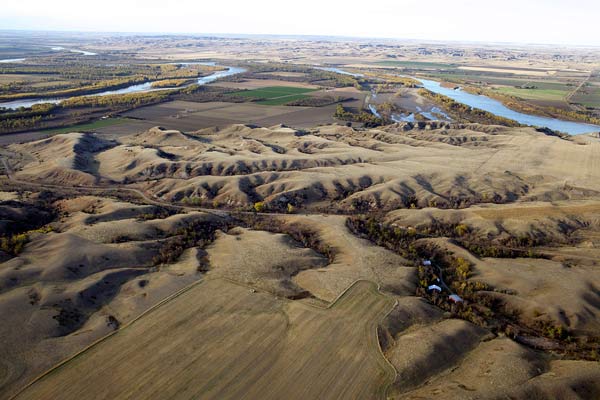Nationally acclaimed photographer Terry Evans and award-winning journalist and filmmaker Elizabeth Farnsworth spent four years exploring the impact of the current oil boom on the Williston Basin region. The resulting exhibition was developed by Chicago’s Field Museum in collaboration with Evans and Farnsworth, both Fellows of the Center for Art + Environment at the Nevada Museum of Art. It opened at the North Dakota Museum of Art in August 2014 and later toured to Bismarck, Ellendale, and Cavalier through the Museum’s Rural Arts Initiative.
Evans has given her complete body of Fractured work, forty-four photographs valued at $163,000, to the North Dakota Museum of Art, portraits and both ground and aerial landscapes. Upon making the gift she said, [I am giving this] “because this work belongs in North Dakota where it was made, in care of the Museum.”
The combination of Evan’ photographs with Farnsworth’s thoughts humanizes the Bakken. Farnsworth, long-time senior correspondent with the MacNeil/Lehrer NewsHour and later the NewsHour with Jim Lehrer, writes about the portraits, “More people are arriving each day, seeking jobs. People move to the Bakken for a variety of reasons. Some, like Daryl Morgan, Dutch Nordyke, and Nolberto Peña, seek a paycheck after losing a business or job in the recession. Others, like Elena Rosca, come from far away to learn something specific—English in her case. Freddie Abbona helps guide drilling by remote control and is well paid, enabling him to bring his family to North Dakota. Some boomers find permanent housing; others live in temporary ‘man camps’ on the edges of towns.”
The landscapes as witnessed by Farnsworth carry a long history. She suggests that Evans’ photograph, The Confluence of the Yellowstone and Missouri Rivers, became “a powerful symbol in American life. It was sacred to some Native American groups and a key landmark for the explorations of Lewis and Clark. Sitting Bull surrendered to American authorities at Ft. Buford on the confluence five years after defeating General Custer on another river, the Little Big Horn, not far away. Flying east from the confluence along the Missouri, we come upon a huge—and steadily expanding—landfill for oil waste. ‘We’ll fill this in two years, more than in our whole history,’ the owner says.” The business opened in 1983. Today it has become history.
“In the place where the Missouri and the Yellowstone Rivers meet, it seems as if Lewis and Clark might suddenly appear, as they did in April 1805 on their Voyage of Discovery. In his journal, Lewis praised these ‘delightful tracts of country.’ So far, the oil industry hasn’t changed the confluence much, but Terry and I have witnessed a continuing upheaval on the bluffs and prairie beyond.”
Farnsworth continues, “Terry’s photographs reveal a constant tension between the industrial facilities and the mysterious beauty and timelessness of the prairie. We were exploring early enough in the boom to still see vast stretches of native prairie, but that is changing. The industry is a juggernaut in the original sense: the word derives from Sanskrit and recalls Vishnu’s image being carried on a cart with large wheels that could crush devotees along its path. Like the Hindu god, the oil industry is at once creative and destructive, the implication of which reach far beyond the prairie.”
Terry Evans has spent decades photographing the prairies and plains of North America and the urban prairie of Chicago. Combining both aerial and ground photography, she delves into the intricate and complex relationships between land and people. Her work explores the virgin prairie; working steel mills; Greenland ice sheets; a small town in the Kansas Flint Hills; the oil boom in North Dakota; and most recently the Chicago story of Petroleum Coke, or petcoke, a coal-like byproduct of oil refining that is sold overseas as a cheap, dirty, cheap, dirty, industrial fuel. Two mountains of petcoke, bigger than the combined stadiums of Wrigley Field and Comiskey Park, have arisen along the urban Calumet River within shouting distance of family homes.
The North Dakota Museum of Art’s permanent collection is gradually accumulating the visual history of our region. “The value of art gifts received in the current fiscal year total $504,350, to be kept in perpetuity for those who follow. This wonderful gift brings us a step closer,” muses Museum Director, Laurel Reuter.
TERRY EVANS, OIL WASTE DUMP BETWEEN TIOGA AND NEW TOWN,
OCTOBER 2011, CHROMOGENIC PRINT MOUNTED ON WOOD PANEL,
44 X 44 INCHES.

TERRY EVANS, CONFLUENCE OF YELLOWSTONE AND MISSOURI RIVER,
OCTOBER 2011, CHROMOGENIC PRINT MOUNTED ON WOOD PANEL,
31 X 44 INCHES.